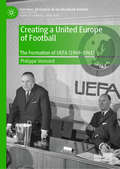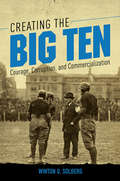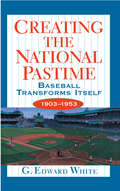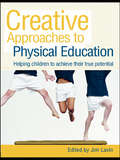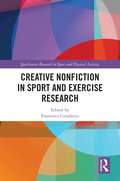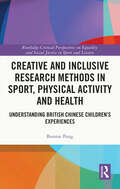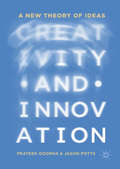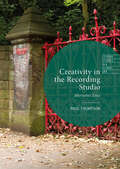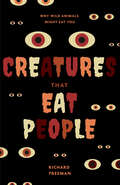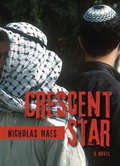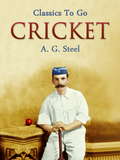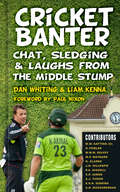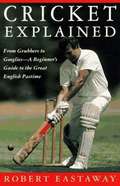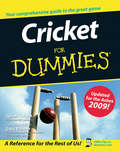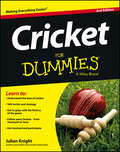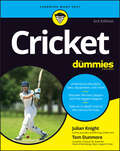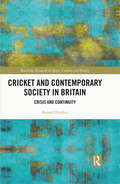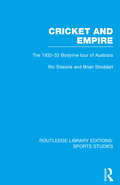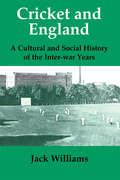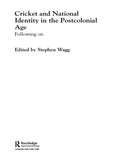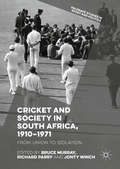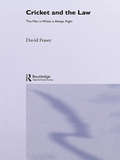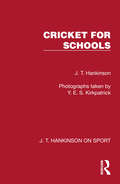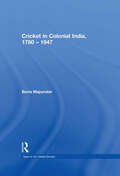- Table View
- List View
Creating a United Europe of Football: The Formation of UEFA (1949–1961) (Football Research in an Enlarged Europe)
by Philippe VonnardThis book provides a historical study of the beginnings of the UEFA, demonstrating how the formation of the organisation was linked to the decentralisation experienced by FIFA, the world governing body of football. Vonnard examines why administrators created an association that transcended the barriers of the Cold War, and focused on the development of a network that promoted football outside the constraints of international politics. Finally, he emphasises the role UEFA played in the Europeanisation of the people’s game, and in the early years of the European integration process. The research is based on a rich body of new archival material from the UEFA and FIFA Documentation Centres, and various European football federations, as well as reports from a number of leading newspapers of the era, and interviews with football personalities of the 1950s. It will be of interest to students and scholars across the history of sport, international relations, and European studies
Creating the Big Ten: Courage, Corruption, and Commercialization
by Winton U SolbergBig Ten football fans pack gridiron cathedrals that hold up to 100,000 spectators. The conference's fourteen member schools share a broadcast network and a 2016 media deal worth $2.64 billion. This cultural and financial colossus grew out of a modest 1895 meeting that focused on football's brutality and encroaching professionalism in the game. Winton U. Solberg explores the relationship between higher education and collegiate football in the Big Ten's first fifty years. This formative era saw debates over eligibility and amateurism roil the sport. In particular, faculty concerned with academics clashed with coaches, university presidents, and others who played to win. Solberg follows the conference's successful early efforts to put the best interests of institutions and athletes first. Yet, as he shows, commercial concerns undid such work after World War I as sports increasingly eclipsed academics. By the 1940s, the Big Ten's impact on American sports was undeniable. It had shaped the development of intercollegiate athletics and college football nationwide while serving as a model for other athletic conferences.
Creating the National Pastime: Baseball Transforms Itself, 1903-1953
by G. Edward WhiteAt a time when many baseball fans wish for the game to return to a purer past, G. Edward White shows how seemingly irrational business decisions, inspired in part by the self-interest of the owners but also by their nostalgia for the game, transformed baseball into the national pastime. Not simply a professional sport, baseball has been treated as a focus of childhood rituals and an emblem of American individuality and fair play throughout much of the twentieth century. It started out, however, as a marginal urban sport associated with drinking and gambling. White describes its progression to an almost mythic status as an idyllic game, popular among people of all ages and classes. He then recounts the owner's efforts, often supported by the legal system, to preserve this image. Baseball grew up in the midst of urban industrialization during the Progressive Era, and the emerging steel and concrete baseball parks encapsulated feelings of neighborliness and associations with the rural leisure of bygone times. According to White, these nostalgic themes, together with personal financial concerns, guided owners toward practices that in retrospect appear unfair to players and detrimental to the progress of the game. Reserve clauses, blacklisting, and limiting franchise territories, for example, were meant to keep a consistent roster of players on a team, build fan loyalty, and maintain the game's local flavor. These practices also violated anti-trust laws and significantly restricted the economic power of the players. Owners vigorously fought against innovations, ranging from the night games and radio broadcasts to the inclusion of African-American players. Nonetheless, the image of baseball as a spirited civic endeavor persisted, even in the face of outright corruption, as witnessed in the courts' leniency toward the participants in the Black Sox scandal of 1919. White's story of baseball is intertwined with changes in technology and business in America and with changing attitudes toward race and ethnicity. The time is fast approaching, he concludes, when we must consider whether baseball is still regarded as the national pastime and whether protecting its image is worth the effort.
Creative Approaches to Physical Education: Helping Children to Achieve their True Potential
by Jim LavinCreative Approaches to Physical Education provides guidance on how to develop innovative new approaches to the delivery of each area of the National Curriculum for PE at Key Stages 2 and 3. The ideas have all been successfully developed in schools where every child has been encouraged to find success and to express themselves in new ways that surprise and delight teachers. Pupils feel ownership of their learning and pride in their achievements, fostering interest, creativity and motivation. Ideal for non-specialist and specialist PE teachers and trainee teachers alike, this book: explores the PE curriculum in a much wider sense than traditional approaches allow covers the key areas of physical education such as games, dance and gymnastics inspires us to look afresh at how we can exploit the learning potential of the outdoors shows how children use skills to express themselves creatively gives innovative suggestions for the use of ICT in PE teaching to encourage independent, personalised leaning examines how physical education can be linked with other subjects in a creative way. Childhood obesity is a growing concern and there are worries that young people have few purposeful leisure interests. This book offers teachers and all those who work with young people alternative approaches and activities that allow young people to express their creative side through physical activity and discover active healthy interests that will last a lifetime.
Creative Nonfiction in Sport and Exercise Research (Qualitative Research in Sport and Physical Activity)
by Francesca CavallerioAcademics around the world recognise the effectiveness of storytelling as a way to engage audiences in conversations, raising awareness of issues, and encouraging change. Stories are now seen as the best medium to convey information to diverse audiences. This book explores a novel approach to representing research findings through the adoption of creative nonfictional stories (CNF). At a time when dissemination of scientific research is constantly highlighted as a fundamental aspect for academics, CNF represents an opportunity to effectively communicate science to non-academic audiences through stories. By providing practical examples of how to transform findings into compelling stories rooted in data, following the mantra of showing rather than telling, which characterises CNF, Creative Nonfiction in Sport and Exercise Research helps researchers – qualitative, quantitative, established professors, and students – to turn their research into stories. A unique contribution to the field, this book is the first in the sport and exercise research field to take scholars on a discovery jouney, moving from their classic realist to a more creative, compelling, but still rigorous representation of research findings. The book features chapters written by authors from different sport research backgrounds, who present the findings of a previously published ‘classic’ study rewritten in the form of a story. Reflective chapters focusing on the how-to and the challenges of this creative analytical practice complete the work, to support scholars in developing their creative skills.
Creative and Inclusive Research Methods in Sport, Physical Activity and Health: Understanding British Chinese Children’s Experiences (Routledge Critical Perspectives on Equality and Social Justice in Sport and Leisure)
by Bonnie PangThis book demonstrates how creative research methods can be used to better understand the experiences of children, particularly in the context of sport, physical activity and health. Extending recent developments in arts-based methods, mobile digital ethnographic methods, participatory visual methods and autoethnography in research with children, the book focuses on British Chinese children – an often-neglected group in research studies – providing new perspectives on diversity and inclusion, innovative research methods and the Chinese diaspora. The book draws on concepts from health and physical education, sport, sociology, and psycho-social studies to shed new light on social dynamics, cultural diversities and contextual changes in British Chinese children’s health-related experiences. It shows how globalisation and international mobility has complicated diversity and difference in the Chinese diaspora, and how creative research methods and reflexivity can be powerful tools for unlocking our understanding of children’s everyday lives. This is fascinating and useful reading for any researcher or advanced student with an interest in innovative research methods, sport, physical activity, health, migration and diaspora studies, childhood and youth studies.
Creativity and Innovation: A New Theory of Ideas
by Jason Potts Prateek GoorhaIdeas are ubiquitous. They are the fundamental building blocks for all aspects of life. Yet, efforts to use ideas as a basic unit of analysis in a shared framework are rare. We often find it difficult to look past the artificial boundaries that academic disciplines and specialist fields of knowledge construct. In this book, the authors address this substantial lacuna by proposing an intuitive theory of ideas that serves as a trans-disciplinary basis for studying innovation and creativity. The theory proposed shows how new ideas emerge from contexts that rely on mechanisms, which were originally built on older and more central ideas. It demonstrates how these mechanisms help instantiate different perspectives on the same idea in variegated manners. By applying their theory to a variety of bat and ball sports, the authors illustrate the role that primitive ideas have on sports innovation, and explore further avenues for employing the theory in a number of different situations. This original book will be of interest to anyone who wishes to gain a deeper understanding of the processes of innovation and creativity, developed within a complex framework of ideas.
Creativity in the Recording Studio: Alternative Takes (Leisure Studies in a Global Era)
by Paul ThompsonPaul Thompson offers an alternative take on the romanticized and mythologized process of record-making. Side A illustrates how creativity arises out of a system in action, and introduces the history, culture, traditions and institutions that contribute to the process of commercial record production. Side B demonstrates this system in action during the central tasks of songwriting, performing, engineering and producing. Using examples from John Lennon, David Bowie, Tupac Shakur, Björk, Marta Salogni, Sylvia Massy and Rick Rubin, each chapter takes the reader inside a different part of the commercial record production process and uncovers the interactive and interrelated multitude of factors involved in each creative task.
Creatures That Eat People: Why Wild Animals Might Eat You
by Richard FreemanWild Animals Might Eat You—Learn Which Ones“Informative and very entertaining”—Readers of Richard’s booksCreatures That Eat People is an action-packed deep dive on predators that turn man eater. Learn about past and present cases on human eating animals—big and small—so you can survive being hunted!Avoid getting eaten!Do you find yourself wondering: Do bears eat humans? Do snakes eat people? Could I survive people-eating predators of any kind? Perfect for anyone with a fun or morbid interest in wildlife or survivalism, Creatures That Eat People is full of stories of strange animals that eat humans and the situations that lead to it.Learn which wild animals might eat you—from an expert. Cryptozoologist, former zookeeper, current zoological director, best-selling author, and animal enthusiast Richard Freeman examines all the cool man eaters in the animal kingdom—so you can be prepared on your next adventure.Inside, you’ll find:Tips for visiting different types of areas with apex predators in themBears, sharks, crocodiles, snakes, and other other weird, wild animals that eat peopleReal-life, thrilling stories of animals eating people—and some survive and some don’tIf you liked How To Survive A Freakin’ Bear Attack, Plants That Kill, Surviving the Wild, or In Search of Real Monsters, and if you enjoyed shows like Tiger King or Human Prey, you’ll love Creatures That Eat People.
Crescent Star
by Nicholas MaesShort-listed for the 2012 Coast Reads Avi Greenbaum is Jewish and lives in West Jerusalem. Moussa Shakir is Palestinian and lives in East Jerusalem. Both are 15 years old, live without their fathers, adore their older brothers, and belong to the same soccer club. Avi commemorates the Holocaust and celebrates Israeli independence, while Moussa mourns on Nakba Day, marking the expulsion of Palestinians from their homes and land in 1948. Their lives are parallel lines: they have everything in common and nothing at all. Each is oblivious to the others existence. As Avi and Moussa go about their daily routines in the spring of 2006, they face reminders of the conflict that has dogged the region for the past three generations the security wall, suicide bombings, police operations, and the looming shadow of war. While navigating this legacy of suspicion and violence, they must decide what their own roles in the stalemate will be.
Cricket
by S. VasanthapriyaThis illustrated book will ensure all cricket-lovers have a pleasurable reading. Starting from the origin of cricket it covers almost everything about cricket.
Cricket (Classics To Go)
by A. G. SteelExcerpt: "Steel played in the first ever Test Match in England at The Oval in 1880, then in the famous Test which England narrowly lost in 1882. The mock obituary was published in The Sporting Times saying "R.I.P. English Cricket...the body will be cremated and the Ashes will be taken to Australia."
Cricket Banter: Chat, Sledging and Laughs from The Middle Stump
by Paul Nixon Dan Whiting Liam KennaCricket Banter is all the rage among the cricketing cognoscenti and the chat, the sledging and the humour behind the game is all covered here, by those boys at The Middle Stump, in conjunction with Factor 50. Here we cover most aspects of cricket, as we speak with some of the finest, funniest, larger than life characters from the sport over the last thirty years, along with a selection of hilarious stories about the game. It’s a highly amusing book; read it and you’ll see why most cricketers, whether from club, county or international level, as well as the sport’s most prominent journalists are all talking about those cheeky chaps from The Middle Stump, and their alternative take on the game of cricket.
Cricket Explained
by Robert EastawayCricket Explained offers the sports enthusiast a user-friendly introduction to baseball's British cousin, a game that shares with America's national pastime the common ancestor "rounders". This is the definitive beginner's guide to the game of cricket, written by a world authority on the sport, the co-inventor of the Coopers & Lybrand World Cricket Ratings System. Cricket Explained takes the reader from the game's fundamentals -- basic rules, terminology, equipment -- to the finer points of strategy, individual playing styles, and cricket lore. The book includes a combined glossary/index for easy reference and is illustrated throughout with the lighthearted drawings of British cartoonist Mark Stevens. So even if you don't know "short leg" from "silly mid off" or a bowler from a batsman, you'll come away from Cricket Explained with an understanding for this truly international sport which, like baseball, is loved both for its elegant simplicity and its vexing complexity. Among the topics covered in Cricket Explained's concise, user-friendly entries are: Cricket's history; Making sense of the action on the field; Batsmen and the batting order; Fielders and fielding positions; Fielding and batting tactics; Scoring and statistics; Bowling strategy; How many players are required; How runs are scored, outs are made, and a game is won; Umpires and the rules; Bowlers and their individual styles; Different types of cricket played throughout the world, and more.
Cricket For Dummies
by Julian Knight Gary Palmer Steve BullWhether you're a weekend cricketer or aspiring armchair expert, Cricket For Dummies helps you make sense of this fascinating sport. Not just a jargon busting guide to cricket's laws, techniques and tactics, it also contains advice on kitting yourself out and provides lessons on playing the game and improving your batting, bowling and fielding skills. For the budding fan, there's a guide to the greatest players, the memorable matches, and a tour through the cricketing scene - both domestic and international - giving you the knowledge you need to fully appreciate this special game.This book has been updated for the Ashes 2009, featuring revised information on new players, the Indian premier league, Stanford 20:20 and the latest coverage of past and future competitions.Julian Knight is a BBC journalist, writer, and cricket enthusiast. He is a former youth coach and captain, and has been a club cricketer for over 20 years.Consultant Editor Gary Palmer played first class cricket for ten years with Somerset before becoming a professional coach.
Cricket For Dummies
by Julian KnightA complete guide to cricket for players and fans alike Whether you're a budding player or aspiring armchair expert, Cricket For Dummies helps you get to grips with this fascinating sport. Completely revised and updated for the first back-to-back Ashes series in 38 years, this hands-on guide gives you clear explanations of the cricket's laws, step-by-step explanations of techniques and tactics, and exciting coverage of the tournaments, global rivalries, and great players. Fully revised and updated to chronicle the rise of twenty20 cricket and the IPL, the implementation of DRS, and the changing face of the game Covers cricket basics—the pitch, the laws, the equipment and more Provides an in-depth look at cricket formats Offers a guide to building cricket skills—bowling, batting, and fielding Includes coverage of the best players and the biggest tournaments throughout the world Complete with Top Ten Lists of the greatest cricketers, the most memorable cricket matches, and the biggest controversies, Cricket For Dummies is your one-stop resource on this popular sport.
Cricket For Dummies
by Julian Knight Tom DunmoreCurious about the game of cricket? Start here! Cricket For Dummies, Third Edition will help you understand the basics of cricket, the internationally popular sport that has leagues around the globe. With this guide, you can enjoy watching matches, and even set up a casual game with friends. The book includes clear explanations of the rules, step-by-step guides to strategy and tactics, and info on all the most popular tournaments around the globe. Learn about the cricket greats of today and yesterday, plus get updates on the latest developments, including Major League Cricket and the Cricket World Cup. This new edition of Cricket For Dummies is a fascinating and thorough introduction to the sport, in the classic, easy-to-understand Dummies style. Learn the laws of cricket so you can watch games and follow league play Set up a game of cricket and play with your friends Get the latest updates in the cricket world, including upcoming must-watch tournaments Figure out the strategies and techniques that make cricket so interestingCricket For Dummies, Third Edition is a valuable resource for new fans who want to understand the game of cricket.
Cricket and Contemporary Society in Britain: Crisis and Continuity (Routledge Research in Sport, Culture and Society)
by Russell HoldenThis book investigates the declining status of cricket within contemporary British society after the high-water mark of England’s Ashes victory in 2005. It considers the deep roots of the game within British national life as well as its ever-changing nature, and reflects upon the current significance and relevance of a sport that many still perceive as deeply traditional and conservative in outlook. Adopting a socio-political approach, the book offers new perspectives on both the contemporary realities of modern cricket and the social, cultural and political condition of modern Britain. Rather than focusing on personality and the detail of match history, the book looks at how the sport has coped with wider societal changes, such as those in Afro-Caribbean and South Asian communities, and how this has demanded adaptation by cricket’s governing authorities. The book also considers the international context in which the game continues to develop and how the initiative with new formats such as Twenty20 has been lost to other cricketing nations, and it offers insight into the continued expansion and recent professionalization of the women’s game, hinting at ways in which cricket as a whole could recapture the public’s imagination. Cricket and Contemporary Society in Britain is an invaluable resource for those studying the sociology of sport, sport history, cultural studies, the politics of sport, cultural identity, sport management and sport development. It is also a fascinating read for anybody with an interest in cricket or in the value of sport in an era of rapid socio-economic, political and cultural change.
Cricket and Empire: The 1932-33 Bodyline Tour of Australia (Routledge Library Editions: Sports Studies)
by Ric Sissons Brian StoddartA great depression, worsening Anglo-Australian relations, the declining British Empire and the challenge from an Australia striving to find a national identity are the context which explain bodyline and its repercussions. Bodyline was a watershed in the history of cricket and politics were publicly seen as part of sport. This book offers a radical reappraisal of bodyline which challenges the official interpretations of the events, and places them in a unique social and political context. .
Cricket and England: A Cultural and Social History of Cricket in England between the Wars (Sport in the Global Society #No. 8)
by Mr Jack WilliamsLooking at the inter-war period, this work explores the relationship between cricket and English social and cultural values.
Cricket and National Identity in the Postcolonial Age: Following On
by Stephen WaggBringing together leading international writers on cricket and society, this important new book places cricket in the postcolonial life of the major Test-playing countries. Exploring the culture, politics, governance and economics of cricket in the twenty-first century, this book dispels the age-old idea of a gentle game played on England's village greens. This is an original political and historical study of the game's development in a range of countries and covers: * cricket in the new Commonwealth: Sri Lanka, Pakistan, the Caribbean and India* the cricket cultures of Australia, New Zealand and post-apartheid South Africa * cricket in England since the 1950s. This new book is ideal for students of sport, politics, history and postcolonialism as it provides stimulating and comprehensive discussions of the major issues including race, migration, gobalization, neoliberal economics, the media, religion and sectarianism.
Cricket and Society in South Africa, 1910–1971: From Union To Isolation (Palgrave Studies in Sport and Politics)
by Richard Parry Bruce Murray Jonty WinchThis book explores how cricket in South Africa was shaped by society and society by cricket. It demonstrates the centrality of cricket in the evolving relationship between culture, sport and politics starting with South Africa as the beating heart of the imperial project and ending with the country as an international pariah. The contributors explore the tensions between fragmentation and unity, on and off the pitch, in the context of the racist ideology of empire, its ‘arrested development’ and the reliance of South Africa on a racially based exploitative labour system. This edited collection uncovers the hidden history of cricket, society, and empire in defining a multiplicity of South African identities, and recognises the achievements of forgotten players and their impact.
Cricket and the Law: The Man in White is Always Right (Routledge Studies in Law, Society and Popular Culture)
by David FraserCricket, law and the meaning of life ... In a readable, informed and absorbing discussion of cricket’s defining controversies – bodyline, chucking, ball-tampering, sledging, walking and the use of technology, among many others – David Fraser explores the ambiguities of law and social order in cricket. Cricket and the Law charts the interrelationship between cricket and legal theory – between the law of the game and the law of our lives – and demonstrates how cricket’s cultural conventions can escape the confines of the game to carry far broader social meanings. This engaging study will be enjoyed by lawyers, students of culture and cricket lovers everywhere.
Cricket for Schools (J. T. Hankinson on Sport)
by J. T. HankinsonOriginally published in 1946, this was primarily a cricket book for schools and contained much that was new at the time. It was written by a schoolmaster, produced in a school, and a unique feature was that the action photographs are of boys who were at that time in the school team. The author had been coaching school cricket of all grades, Junior Games, House Games, and 1st XI teams for about 20 years, and was at the time of publication in charge of the cricket at Canford School, which, for a relatively small school, had recently produced some very good sides and players. In this book his methods are analysed in a style felt likely to commend itself to readers of all ages.There are 97 action photographs to illustrate the author’s teaching.While this book was primarily for schools, the instructional detail and the attractiveness of the photographs would also have appealed to more mature cricketers and the book was strongly recommended to all who are interested in the game. Today it can be enjoyed in its historical context.
Cricket in Colonial India, 1780–1947 (Sport In The Global Society Ser.)
by Boria MajumdarThis is an exacting social history of Indian cricket between 1780 and 1947. It considers cricket as a derivative sport, creatively adapted to suit modern Indian socio-cultural needs, fulfil political imperatives and satisfy economic aspirations. Majumdar argues that cricket was a means to cross class barriers and had a healthy following even outside the aristocracy and upper middle classes well over a century ago. Indeed, in some ways, the democratization of the sport anticipated the democratization of the Indian polity itself. Boria Majumdar reveals the appropriation, assimilation and subversion of cricketing ideals in colonial and post-colonial India for nationalist ends. He exposes a sport rooted in the contingencies of the colonial and post-colonial context of nineteenth- and twentieth-century India. Cricket, to put it simply, is much more than a ‘game’ for Indians. This study describes how the genealogy of their intense engagement with cricket stretches back over a century. It is concerned not only with the game but also with the end of cricket as a mere sport, with Indian cricket’s commercial revolution in the 1930s, with ideals and idealism and their relative unimportance, with the decline of morality for reasons of realpolitik, and with the denunciation, once and for all, of the view that sport and politics do not mix. This book was previously published as a special issue of the International Journal of the History of Sport
